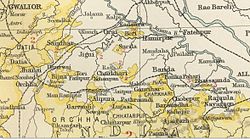| Dhurwai Estate(jagir) Dhurwai State | |||||||
|---|---|---|---|---|---|---|---|
| Princely Estate (Jagir) until 1800. Princely State during the British Raj | |||||||
| 1690–1950 | |||||||
Flag | |||||||
 Dhurwai State in the Imperial Gazetteer of India | |||||||
| Capital | Dhurwai 25°19′N79°03′E / 25.317°N 79.050°E | ||||||
| Area | |||||||
• 1941 | 47 km2 (18 sq mi) | ||||||
| Population | |||||||
• 1941 | 2,423 | ||||||
| History | |||||||
• Established | 1690 | ||||||
| 1950 | |||||||
| |||||||
Dhurwai was a princely state in India during the British Raj. It was one of the Hasht-Bhaiya Jagirs, under the Bundelkhand Agency of British India. Its capital was the town of Dhurwai, with a population of 777 in 1901. [1] Today it is part of Jhansi District, in the state of Uttar Pradesh. Dhurwai was administered by the native ruler, who was addressed as Indian Prince by the British authorities.
